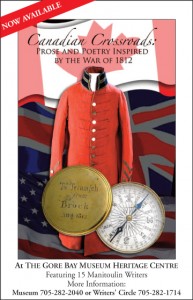 I have settled into Manitoulin once again, while publicity activities in the fall for We All Become Stories continues to be brewing behind the scenes. What is most exciting will be my first attempt at crowd-funding, and reaching out actively online to the growing audience for content and conversations regarding the realities of aging. More on that soon.
I have settled into Manitoulin once again, while publicity activities in the fall for We All Become Stories continues to be brewing behind the scenes. What is most exciting will be my first attempt at crowd-funding, and reaching out actively online to the growing audience for content and conversations regarding the realities of aging. More on that soon.
This past weekend, I was quite excited to pick up a copy of Canadian Crossroads: Prose and Poetry Inspired by The War of 1812 by 15 Manitoulin writers. My contribution is a poem entitled “Quilt Trails”, which speaks of another way that women’s often silenced voices are heard. Meaningful codes were woven into the traditional quilt art form in order to assist people seeking safety or liberty during the war.
Here is the full press release prepared by Margo Little:
In keeping with the national commemoration of the War of 1812, the Gore Bay Museum and the Manitoulin Writers’ Circle have collaborated on a creative response to characters and events prominent in the North American conflict from 1812 to 1815. Canadian Crossroads, a collection of speculative fiction, essays and poetry, released in June 2013, features fifteen Ontario contributors. The unveiling of the book is timed to complement the historical re-enactments and exhibitions taking place in communities throughout Ontario and Quebec.
The bicentennial of the War of 1812 prompted the minister of the Department of Canadian Heritage and Official Languages to establish the Celebration and Commemoration Program to finance community projects such as the Canadian Crossroads initiative. According to the Honourable James Moore, P.C., M.P., the fund is intended to give Canadians “the opportunity to share our experiences, our stories, our myths and our symbols.” In addition, the Royal Ontario Museum has supplied an image of an iconic British redcoat for the cover design accompanied by a compass engraved “To Tecumseh from Brock, August 1812.”
Throughout the book there are full colour illustrations depicting artifacts from the Gore Bay Museum collection. These include a gold uniform button, musket powder flasks, powder measuring cups, war medals as well as a map and engineer’s drawings of Drummond Island fortifications (July 1815).
The prolonged war involving British troops, First Nations warriors and American forces was waged on many fronts and resulted in tremendous loss of life. According to the statistics compiled by the Windsor Community Museum, American casualties were listed as 15,000; British and Canadian 10,000 and Natives 7,500 to 10,000.
Organizers of the unique Manitoulin project worked for eighteen months on the research and peer critiquing with a sneak preview of the first drafts of poetry and prose at museum readings in July 2012. Contributors to the Canadian Crossroads collection include Mindemoya poet Fay Becks, Kagawong writers Connie Suite and Sharon Jackson, Ice Lake authors Linda Willson and Chuc Willson, Long Bay fiction writer Julia Snell, Gore Bay wordsmiths Jeanette Baumann, Pam McLaughlin and Evelyn Cardiff. Spring Bay’s Vincente Belenson has provided a humourous look at the “winners and losers” in the interminable war. Childhood experiences in the Fort Erie area have inspired Lori Thompson of Tehkummah to reflect on the battles fought on that familiar soil.
Manitoulin summer resident, Ann Elizabeth Carson, penned Quilt Trails for the anthology and Copper Cliff resident Vera Constantineau examined the barriers to communication facing families in wartime. The preface to Canadian Crossroads by Gore Bay Museum curator Nicole Weppler gives readers insight into the birth of Canada as a nation.
Canadian Crossroads is not intended as a factual examination of the participants or outcome of the war. Rather the writers used historical accounts as a catalyst for creativity as they generated letters, diaries, film scripts, short stories and poetry. Canadian Crossroads is available from The Gore Bay Museum (705-282-2040). For more information contact the Manitoulin Writers’ Circle at 705-282-1714.
